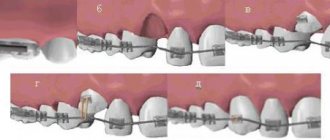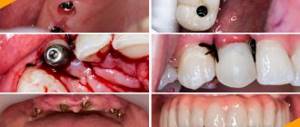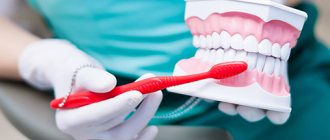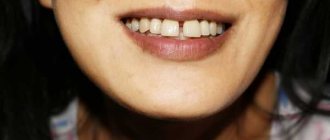Tooth loss is a natural process, but only if it happens in due time. In childhood, the primary dentition is replaced by permanent teeth, and this does not cause concern to either doctors or parents. But if an adult’s teeth fall out, this is a serious reason to think about your health and be sure to consult a doctor.
With questions about tooth loss in adults, a FAN turned to the chief doctor of the “All Ours!” network of dental clinics. Igor Repin and found out that this problem can affect everyone, but avoiding it is much easier than it seems.
Caries
The most common cause of tooth loss is tooth decay. With this disease, the tooth crown is destroyed and the root system is weakened, as a result of which the tooth simply falls out. This happens if caries is not treated and oral hygiene is not maintained.
In this case, the tooth root, as a rule, remains in the bone tissue under the gum and if it is not removed in time, inflammation may develop.
To prevent tooth loss, you need to contact your dentist at the first signs of caries; these may be:
- the presence of carious cavities are dark spots on the tooth enamel. At the initial stage of the disease, they may not be present, or the patient may not see them on their own.
- pain when the tooth gets hot/cold, or sour, sweet or salty food and liquid;
- pain when pressing on the tooth and when chewing;
- bad breath;
- in the later stages - severe destruction of the crown.
Tooth fell out: what to do
The loss of even one tooth leads to changes in the dentition and disruption of the dental system. As a result, a number of problems can arise:
- improper jaw closure
- increased stress on healthy teeth
- overload of facial muscles and temporomandibular joints
- headache
If all the teeth have fallen out, the proportions of the face change, and the person seems older than he really is. Therefore, in case of partial or complete adentia, it is necessary to restore the integrity of the dentition as quickly as possible. One of the most effective methods is implantation.
The artificial root performs all the functions of a real one and is securely fixed in the bone tissue. An aesthetic crown is installed on it. Thanks to the high precision of manufacturing, it is completely indistinguishable from real teeth.
Implants will help restore the functioning of the dental system, even if all teeth have fallen out, thanks to the All-on-4 and All-on-6 prosthetic methods. Implantation is the only way to completely restore the dentition without the sensation of artificial teeth.
The loss of even one tooth negatively affects the functioning of the dental system, so it is better to promptly seek help from a dentist. He will find out the cause of tooth loss in adults and prescribe effective treatment that will help avoid functional changes.
Periodontal disease
Periodontal disease is a disease that affects the gums and bone tissue around the tooth. With periodontal disease, atrophy of gum tissue occurs, so-called gum pockets are formed, and bacterial plaque is deposited in them, provoking further inflammation. The gums around the tooth shrink, exposing the lower part and, in some cases, the root. And the tooth itself gradually loosens and leaves the tooth socket.
Periodontal disease is often accompanied by inflammation, bad breath, sore gums, and increased tooth sensitivity.
But periodontal disease leads to tooth loss only in an advanced stage if measures are not taken for a long time. If you consult a doctor at the first signs of illness, unpleasant consequences can be avoided. And if you follow hygiene rules and do not overindulge in sweets, then the development of periodontal disease itself can be prevented.
The best way to fill a defect in the dentition is implantation
There are several technologies for dental prosthetics for partial loss. Today, the best way to restore teeth is implantation. This method is the most reliable (modern implants take root in 98-99% of cases, service life is more than 20 years and even a lifetime), the most aesthetic, functional and comfortable to use, because implants imitate the root of a tooth. It is also very important that during implantation there is no need to grind down adjacent healthy teeth.
The only thing better than implantation is your own tooth!
When a front molar is lost, implantation with immediate loading is often performed. With its help, the dentist immediately after installing the implant, without waiting for its osseointegration, installs a temporary crown that covers the aesthetic defect. The temporary crown is removed from the bite and is often bonded to adjacent teeth. After 2-6 months, the temporary crown is replaced with a permanent one. Immediate loading is carried out for aesthetic, not medical reasons. When a tooth is 100% subject to extraction (for example, with a longitudinal root fracture), but has not yet been removed, it is possible to perform an operation to remove the tooth and install an implant at the same time. In this case, the period of complete treatment is reduced by 3-4 months, and the cost is slightly reduced.
Periodontitis
Periodontitis is an inflammation of the soft tissues of the oral cavity. If left untreated, it causes weakening of the ligamentous apparatus of the tooth. The gum becomes inflamed, destroyed, the fixation of the tooth in the socket is weakened, under the influence of regular chewing load it becomes loose and eventually falls out. Often with periodontitis, the tooth root is exposed.
Periodontitis causes not only poor oral health and bacteria, but also allergic reactions, gum injuries, hormonal imbalance, weakened immunity and a number of other reasons.
Moreover, if periodontitis is generalized, that is, spread over the entire jaw, the matter may not be limited to one lost tooth and other dental units will follow. If periodontitis is not treated at all, it can lead to complete edentia.
The first signs of the disease, for which you should go to the clinic, are bleeding gums, discomfort, and itching. This may be followed by pain when chewing, an unpleasant odor, and purulent discharge.
In severe periodontitis, the teeth become displaced and loosened, exposing the lower part of the tooth and the root. The disease should definitely not be brought to this stage, since it can only be cured through surgery.
Making a butterfly prosthesis
This method of prosthetics is the least reliable and comfortable. Therefore, such a prosthesis can be exclusively temporary. It solves aesthetic problems, but not functional ones. A removable denture is made of acrylic (plastic) or nylon. It has many disadvantages: the prosthesis is mobile, impairs diction, sometimes there are allergic reactions to the material from which it is made, it is not functional - it restores chewing function by less than 50%, and wears out quickly. But it is the most inexpensive. Therefore, the best use is to temporarily close the defect while the implant heals.
Age-related changes
If the main causes of adentia can be identified and neutralized in time, age-related tooth loss is an inevitable phenomenon. In old age, the immune system weakens, the gums atrophy and decrease in volume, the neck of the tooth becomes exposed, teeth become mobile and fall out.
Most often this happens at the age of 65-70, but if the patient did not take care of his teeth and did not follow preventive recommendations, negative consequences may appear earlier.
It is not possible to prevent this, but you can delay it by taking vitamins, medications that boost immunity, carefully monitor your physical condition and lead a healthy lifestyle.
Temporary prosthetics of the front tooth
Since at the moment the patient cannot begin implantation and dental prosthetics with ceramic crowns, and the absence of a front tooth greatly affects the aesthetics, it was decided to perform a temporary prosthesis for the front tooth. An adhesive cuspid bridge was chosen as a temporary prosthesis.
To make a temporary dental prosthesis, impressions of the teeth must be taken. Taking impressions of teeth in the traditional way, using impression material, is not suitable for all patients: some patients experience a gag reflex when taking impressions, and it becomes impossible to remove the impression, and some patients with loose teeth experience nervousness, fearing that they will lose a tooth when taking an impression.
Family Dentistry offers an alternative to traditional impressions - dental scanning. Using dental scanning, the doctor receives three-dimensional digital models of the jaws, from which he can model crowns, inlays and dentures. The doctor transfers the digital models and simulation results to the dental technician, who makes the dental restorations.
The front tooth prosthesis is made of aesthetic plastic. Such a tooth will be attached to the neighboring ones with special linings on the inside, that is, the neighboring teeth are not ground down.
This option is temporary, but it restored the aesthetics well. Later, when the patient is ready, the front tooth will be restored with a ceramic crown on an implant, and the neighboring ones will be restored with ceramic crowns - then the aesthetics will be ideal.
Other Possible Causes
In addition to oral diseases, other factors can cause edentia:
- diabetes mellitus, in which blood sugar levels are abnormal, leading to excess glucose. This, in turn, provokes a disruption of the blood supply to the gum tissues, which weaken and the tooth falls out;
- heart diseases, in most cases requiring regular use of medications that disrupt the functions of mucous tissues, which also leads to loss of teeth;
- hypertension and other chronic diseases;
- mechanical injuries;
- metabolic disease;
- weakened immunity;
- poor diet, excessive sugar consumption;
- bad habits (smoking, excessive alcohol consumption, drug addiction);
- hereditary predisposition to adentia;
- failure to comply with hygiene standards and improper oral care, which provokes the growth of bacteria that weaken the gums and cause inflammation.
Why do teeth fall out
Each tooth is located in its own socket and is securely held in it thanks to the periodontium. This is a whole complex of tissues, which includes root cement, dentogingival ligament and alveolar bone. They perfectly perform supporting and holding functions until inflammatory processes begin in the tissues. As a rule, the latter occur due to poor oral hygiene.
Within two hours after brushing your teeth, plaque begins to accumulate on them. It consists of food particles, saliva, the minerals it contains, and bacteria. There are especially many of them near the gums and between the teeth. Over time, plaque mineralizes and turns into tartar. It is the main cause of most dental diseases, including those associated with periodontal disease.
Inflammation of the tissues holding the tooth in the socket can be quite severe against the background of metabolic disorders, diabetes mellitus, thyroid disease, hypovitaminosis and osteoporosis.
How to prevent tooth loss
Preventing tooth loss is not so difficult; all you need to do is follow a few recommendations:
- Quitting smoking and alcohol.
- Normalization of diet, refusal of harmful foods, dyes, synthetic additives.
- Minimum sugar consumption or complete refusal of it.
- Avoiding sugary soda is the main enemy of healthy teeth.
- Maintaining hygiene means regularly brushing your teeth and rinsing with special solutions after meals.
- Regular professional cleaning of the oral cavity - removal of tartar and other deposits.
- If the immune system is weakened, take immunomodulators.
- Regular dental checkups.
If you have chronic diseases and other risk factors, you should pay increased attention to dental health and regularly visit a specialist. This will allow you to detect potential problems in time and eliminate them. But it is much simpler and cheaper than prosthetics.
What to do to prevent dental problems
Since childhood, we know that we need to take care of our teeth. Loving parents instill a healthy habit; they teach about brushing teeth in kindergarten and then at school. Unfortunately, even if you brush your teeth correctly, it is impossible to completely remove all plaque at home. For this purpose, there is special dental equipment that allows you to remove all types of deposits, even in hard-to-reach places. The procedure is called “professional hygiene” and is carried out twice a year. High-quality care will help avoid many problems with teeth and gums.
Diseases of the body: impact on the condition of teeth
The second group includes chronic diseases that affect overall health - diabetes, hypertension, osteoporosis, arthritis.
Due to diabetes mellitus , metabolic disorders occur, since the body contains too many carbohydrates, and tooth enamel is gradually destroyed. Teeth are attacked by bacteria and caries often develops at lightning speed. With osteoporosis , bones are destroyed, calcium and fluoride disappear from dental tissues, as a result, teeth weaken, begin to crumble and fall out. Most often, this disease develops after 45 years from a lack of calcium in the body, but, fortunately, osteoporosis can be successfully treated.
Additional factors for tooth loss include smoking . Statistics show that among middle-aged people who have lost teeth, about 30% are smokers.
Treatment of tooth canals under a microscope
To eliminate inflammation at the roots of the two front teeth, dental canal treatment was performed under a microscope. The significant magnification provided by the microscope helps to thoroughly clean the canals of the teeth and not miss the branches and bends of the canals. Thanks to the professionalism of the endodontist and excellent equipment, the infection in the canals, which causes inflammation at the roots, is completely eliminated.
After dental treatment under a microscope, the canals are hermetically sealed and the bone at the roots is restored. Treatment under a microscope saves teeth from removal.
Pros and cons of temporary solutions
The advantages of temporary orthopedic structures are as follows:
- fast production,
- quite good aesthetics at first,
- low cost.
The disadvantages include, first of all, not very reliable fixation - even non-removable temporary ones can come off and fall out while chewing food. The disadvantages include low strength and rapid loss of aesthetics. Since the surface of plastic and composite materials is porous, food deposits, pigments, and microbes settle on it - and it is impossible to bleach the product to its original appearance.
The cost of restoring a smile
The cost of prosthetics depends on what type of prosthetics was used, what materials were used, whether additional manipulations were necessary - treatment, root removal. So, for example, prices for metal-ceramic crowns start from 7,000 rubles, ceramic ones - from 20 thousand, zirconium dioxide - from 25 thousand rubles. Installing an implant will cost at least another 20-30 thousand. Temporary orthopedic structures cost from 2,000 rubles.
1Goldstein R. Aesthetic dentistry, 2003.
Your questions and answers
QUESTION Hello, my front side tooth is broken. And it broke almost at the root. From the outside it is very noticeable. What is the best way to “fix” it? Or just delete, and there are no other options? Vladislav K.
ANSWER Hello, Vladislav. If the root of a broken tooth is healthy, then it may well serve as a support for a prosthesis. But you can find out more about this at a face-to-face appointment with a dentist, because... you need to take an x-ray and see “what’s inside.” Further, as for the “repair” - prosthetics, you can install a crown (preferably ceramic) supported by a pin or stump inlay. But even if the dentist insists on removal, do not rush to install a regular bridge, because... it will require the use of 2 healthy teeth at the edges. You will have to grind them down and remove the “nerve” - this will reduce the service life of the supporting teeth. Plus they will be overloaded. Therefore, if removal cannot be avoided, then the ideal option is an implant with a crown on top.
Author: Chorny S.V. (Thank you for your help in writing the article and the information provided)
Is it difficult to get used to dentures?
The process of adaptation occurs almost imperceptibly if the orthopedic design is as close as possible in shape and size to the lost natural tooth. For example, classic artificial crowns, bridges or dentures on implants do not cause discomfort after installation - especially if the tooth was lost recently. It takes several weeks to get used to removable “butterflies”, because... artificial gums and clasps seem foreign. To speed up adaptation, you can recite tongue twisters, read poems, and stories out loud.
“I very quickly got used to my metal-ceramic crown. She just fit in perfectly. And there were no unpleasant sensations at all. On the contrary, I was getting used to the fact that I was finally comfortable chewing and it didn’t hurt. You can say that I got used to the feeling of happiness, that everything is normal in my mouth now.”
Tatiana S., review from gidpozubam.ru
Prevention
It is important not only to understand the causes of the problem, but also to have a good idea of how to prevent tooth loss. There are some simple recommendations:
- Visit your dentist regularly and be attentive to your health. Many oral diseases begin to manifest themselves at a very early stage.
- Give up bad habits. You will need to reduce the consumption of alcohol and cigarettes, or completely eliminate them.
- Be careful about the products you eat. The less fat, sugar, and dyes in food, the better.
- Maintain good oral hygiene. It is better to buy an electric toothbrush, water flosser, and floss. It is also worth visiting a dentist for professional cleaning and removal of hard plaque.
Since many problems appear with reduced immunity, it needs to be strengthened by all means.
If you do not want to face a problem such as tooth loss, contact our dentists. They are ready to conduct a preventive examination and address most health problems.
You can make regular appointments with us according to a previously drawn up schedule. We guarantee quality treatment at affordable prices.










